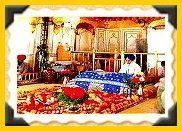Und3rgr0und J4tt1
Prime VIP
Sikh Scriptures

Sikhs have two primary sources of scriptures: the Guru Granth Sahib and the Dasam Granth. The Guru Granth Sahib may be referred to as the Adi Granth—literally, The First Volume—and the two terms are often used synonymously. Here, however, the Adi Granth refers to the version of the scripture created by Arjan Dev in 1604. The Guru Granth Sahib refers to the final version of the scripture created by Gobind Singh.
Adi Granth : It is believed that the Adi Granth was compiled primarily by Bhai Gurdas under the supervision of Arjan Dev between the years 1603 and 1604. It is written in the Gurmukhi script, which is a descendant of the La??a script used in the Punjab at that time. The Gurmukhi script was standardised by Arjan Dev for use in the Sikh scriptures and is thought to have been influenced by the Sarada and Devanagari scripts. An authoritative scripture was created to protect the integrity of hymns and teachings of the Sikh gurus and selected bhagats. At the time, Arjan Dev tried to prevent undue influence from the followers of Prithi Chand, the guru's older brother and rival.
The original version of the Adi Granth is known as the kartarpur bir and is currently held by the Sodhi
 family of Kartarpur.
family of Kartarpur.
Guru Granth Sahib : The final version of the Guru Granth Sahib was compiled by Guru Gobind Singh. It consists of the original Adi Granth with the addition of Guru Teg Bahadur's hymns. It is believed that it was decreed by Gobind Singh that the Granth was to be considered the eternal, living guru of all Sikhs, however, this belief finds no mention either in 'Guru Granth Sahib' or in 'Dasham Granth' compiled by Guru Gobind Singh.
Sabb sikkhao ko hukam hai guru manyo granth.
English Transliteration : All Sikhs are commanded to take the Granth as Guru.
It contains compositions by the first five gurus, Guru Teg Bahadur and just one salok (couplet) from Guru Gobind Singh. It also contains the traditions and teachings of sants (saints) such as Kabir, Namdev, Ravidas and Sheikh Farid along with several others.
The bulk of the scripture is classified into rags, with each rag subdivided according to length and author. There are 31 main rags within the Guru Granth Sahib. In addition to the rags, there are clear references to the folk music of Punjab. The main language used in the scripture is known as Sant Bhasa, a language related to both Punjabi and Hindi and used extensively across medieval northern India by proponents of popular devotional religion.[4] The text further comprises over 5000 sabads, or hymns, which are poetically constructed and set to classical form of music rendition, can be set to predetermined musical tal, or rhythmic beats.
The Granth begins with the Mul Mantra, an iconic verse created by Nanak:
ISO 15919 transliteration: Ika oankara sati namu karata purakhu nirabha'u niravairu akala murati ajuni saibham gura prasadi.
Simplified transliteration: Ik oa?nar sat nam karta purkh nirbha'u nirvair akal murat ajuni saibham gur prasad.
English: One Universal Creator God, The Name Is Truth, Creative Being Personified, No Fear, No Hatred, Image Of The Timeless One, Beyond Birth, Self Existent, By Guru's Grace.
All text within the Granth is known as gurbani. Gurbani, according to Nanak, was revealed by God directly, and the authors wrote it down for the followers. The status accorded to the scripture is defined by the evolving interpretation of the concept of guru. In the Sant tradition of Nanak, the guru was literally the word of God. The Sikh community soon transferred the role to a line of men who gave authoritative and practical expression to religious teachings and traditions, in addition to taking socio-political leadership of Sikh adherents. Gobind Singh declared an end of the line of human gurus, and now the Guru Granth Sahib serves as the eternal guru, with its interpretation vested with the community.
Dasam Granth : The Dasam Granth (formally dasve' patsah ki granth or The Book of the Tenth Master)
 is an eighteenth-century collection of miscellaneous works generally attributed to Guru Gobind Singh. The teachings of Gobind Singh were not included in Guru Granth Sahib, the holy book of the Sikhs, and instead were collected in the Dasam Granth. Unlike the Guru Granth Sahib, the Dasam Granth was never declared to hold guruship. The authenticity of some portions of the Granth has been questioned and the appropriateness of the Granth's content still causes much debate.
is an eighteenth-century collection of miscellaneous works generally attributed to Guru Gobind Singh. The teachings of Gobind Singh were not included in Guru Granth Sahib, the holy book of the Sikhs, and instead were collected in the Dasam Granth. Unlike the Guru Granth Sahib, the Dasam Granth was never declared to hold guruship. The authenticity of some portions of the Granth has been questioned and the appropriateness of the Granth's content still causes much debate.
The entire Granth is written in the Gurmukhi script, although most of the language is Braj and not Punjabi. Sikh tradition states that Mani Singh collected the writings of Gobind Singh after his death to create the Granth.
From 1892 to 1897, scholars assembled at the Akal Takht, Amritsar, to study the various printed Dasam Granths and prepare the authoritative version. They concluded that the Dasam Granth was entirely the work of Gobind Singh. Further re-examinations and reviews took place in 1931, under the Darbar Sahib Committee of the Shiromani Gurdwara Prabandhak Committee they too vindicated the earlier conclusion..
Janamsakhis : The Janamsakhis (literally birth stories), are writings which profess to be biographies of Guru Nanak Dev. Although not scripture in the strictest sense, they provide an interesting look at Nanak's life and the early start of Sikhism. There are several—often contradictory and sometimes unreliable—Janamsakhis and they are not held in the same regard as other sources of scriptural knowledge.

Sikhs have two primary sources of scriptures: the Guru Granth Sahib and the Dasam Granth. The Guru Granth Sahib may be referred to as the Adi Granth—literally, The First Volume—and the two terms are often used synonymously. Here, however, the Adi Granth refers to the version of the scripture created by Arjan Dev in 1604. The Guru Granth Sahib refers to the final version of the scripture created by Gobind Singh.
Adi Granth : It is believed that the Adi Granth was compiled primarily by Bhai Gurdas under the supervision of Arjan Dev between the years 1603 and 1604. It is written in the Gurmukhi script, which is a descendant of the La??a script used in the Punjab at that time. The Gurmukhi script was standardised by Arjan Dev for use in the Sikh scriptures and is thought to have been influenced by the Sarada and Devanagari scripts. An authoritative scripture was created to protect the integrity of hymns and teachings of the Sikh gurus and selected bhagats. At the time, Arjan Dev tried to prevent undue influence from the followers of Prithi Chand, the guru's older brother and rival.
The original version of the Adi Granth is known as the kartarpur bir and is currently held by the Sodhi

Guru Granth Sahib : The final version of the Guru Granth Sahib was compiled by Guru Gobind Singh. It consists of the original Adi Granth with the addition of Guru Teg Bahadur's hymns. It is believed that it was decreed by Gobind Singh that the Granth was to be considered the eternal, living guru of all Sikhs, however, this belief finds no mention either in 'Guru Granth Sahib' or in 'Dasham Granth' compiled by Guru Gobind Singh.
Sabb sikkhao ko hukam hai guru manyo granth.
English Transliteration : All Sikhs are commanded to take the Granth as Guru.
It contains compositions by the first five gurus, Guru Teg Bahadur and just one salok (couplet) from Guru Gobind Singh. It also contains the traditions and teachings of sants (saints) such as Kabir, Namdev, Ravidas and Sheikh Farid along with several others.
The bulk of the scripture is classified into rags, with each rag subdivided according to length and author. There are 31 main rags within the Guru Granth Sahib. In addition to the rags, there are clear references to the folk music of Punjab. The main language used in the scripture is known as Sant Bhasa, a language related to both Punjabi and Hindi and used extensively across medieval northern India by proponents of popular devotional religion.[4] The text further comprises over 5000 sabads, or hymns, which are poetically constructed and set to classical form of music rendition, can be set to predetermined musical tal, or rhythmic beats.
The Granth begins with the Mul Mantra, an iconic verse created by Nanak:
ISO 15919 transliteration: Ika oankara sati namu karata purakhu nirabha'u niravairu akala murati ajuni saibham gura prasadi.
Simplified transliteration: Ik oa?nar sat nam karta purkh nirbha'u nirvair akal murat ajuni saibham gur prasad.
English: One Universal Creator God, The Name Is Truth, Creative Being Personified, No Fear, No Hatred, Image Of The Timeless One, Beyond Birth, Self Existent, By Guru's Grace.
All text within the Granth is known as gurbani. Gurbani, according to Nanak, was revealed by God directly, and the authors wrote it down for the followers. The status accorded to the scripture is defined by the evolving interpretation of the concept of guru. In the Sant tradition of Nanak, the guru was literally the word of God. The Sikh community soon transferred the role to a line of men who gave authoritative and practical expression to religious teachings and traditions, in addition to taking socio-political leadership of Sikh adherents. Gobind Singh declared an end of the line of human gurus, and now the Guru Granth Sahib serves as the eternal guru, with its interpretation vested with the community.
Dasam Granth : The Dasam Granth (formally dasve' patsah ki granth or The Book of the Tenth Master)

The entire Granth is written in the Gurmukhi script, although most of the language is Braj and not Punjabi. Sikh tradition states that Mani Singh collected the writings of Gobind Singh after his death to create the Granth.
From 1892 to 1897, scholars assembled at the Akal Takht, Amritsar, to study the various printed Dasam Granths and prepare the authoritative version. They concluded that the Dasam Granth was entirely the work of Gobind Singh. Further re-examinations and reviews took place in 1931, under the Darbar Sahib Committee of the Shiromani Gurdwara Prabandhak Committee they too vindicated the earlier conclusion..
Janamsakhis : The Janamsakhis (literally birth stories), are writings which profess to be biographies of Guru Nanak Dev. Although not scripture in the strictest sense, they provide an interesting look at Nanak's life and the early start of Sikhism. There are several—often contradictory and sometimes unreliable—Janamsakhis and they are not held in the same regard as other sources of scriptural knowledge.
